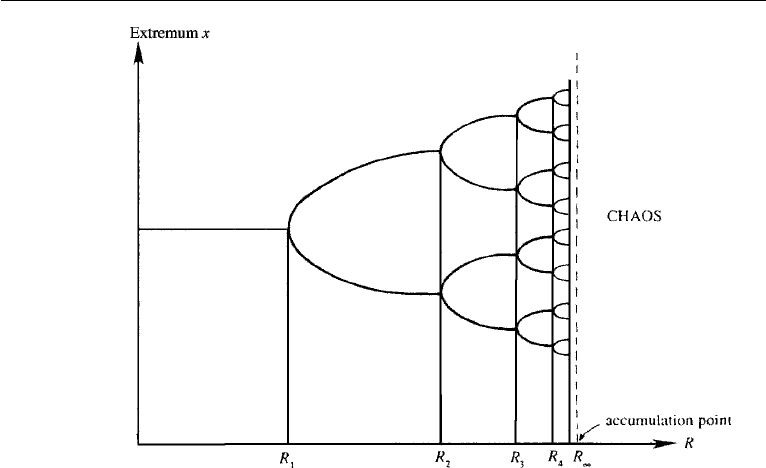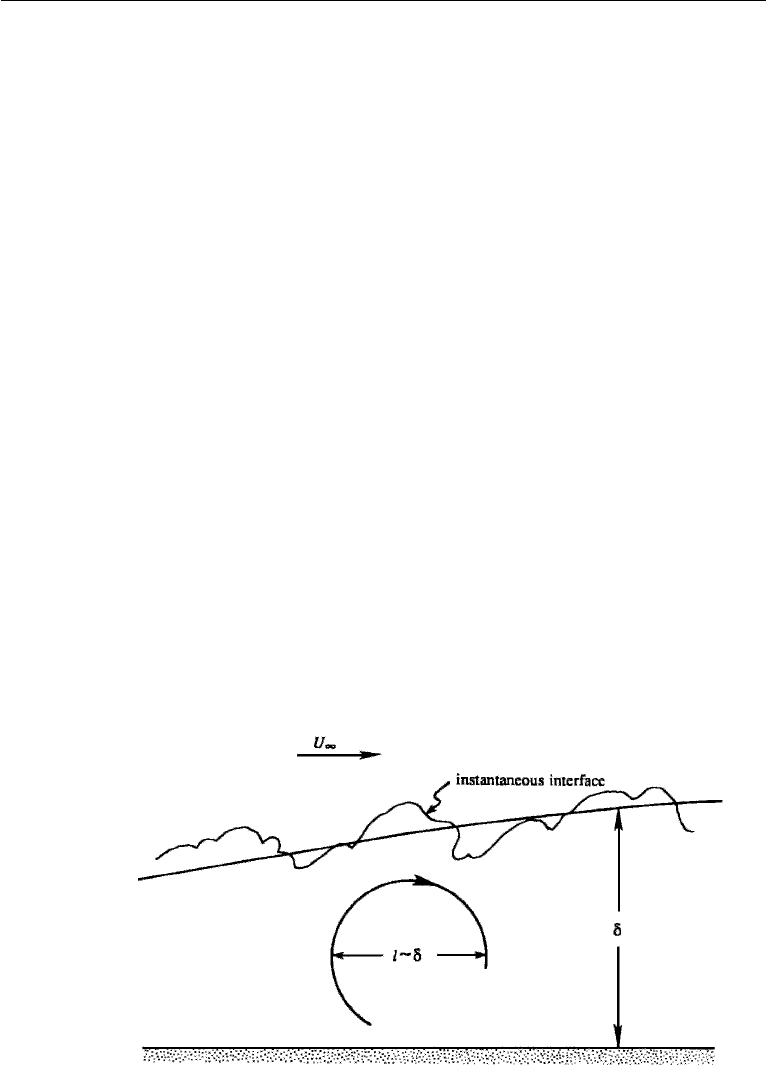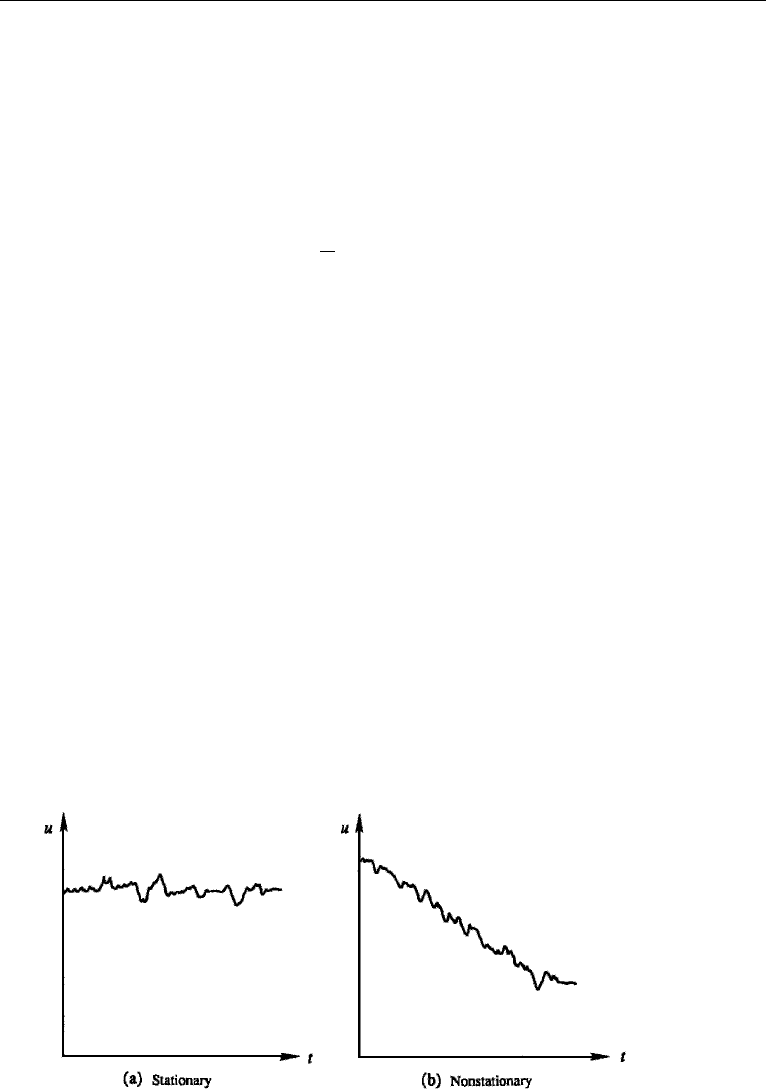Cohen I.M., Kundu P.K. Fluid Mechanics
Подождите немного. Документ загружается.


532 Instability
Figure 12.31 Bifurcation diagram during period doubling. The period doubles at each value R
n
of the
nonlinearity parameter. For large n the “bifurcation tree” becomes self similar. Chaos sets in beyond the
accumulation point R
∞
.
limit cycle with frequency ω
1
.AsR is increased, two more frequencies
(ω
2
and ω
3
) appear through additional bifurcations. In this scenario the ratios
of the three frequencies (such as ω
1
/ω
2
) are irrational numbers, so that the
motion consisting of the three frequencies is not exactly periodic. (When the
ratios are rational numbers, the motion is exactly periodic. To see this, think
of the Fourier series of a periodic function in which the various terms repre-
sent sinusoids of the fundamental frequency ω and its harmonics 2ω,3ω,....
Some of the Fourier coefficients could be zero.) The spectrum for these sys-
tems suddenly develops broadband characteristics of chaotic motion as soon
as the third frequency ω
3
appears. The exact point at which chaos sets in is
not easy to detect in a measurement; in fact the third frequency may not be
identifiable in the spectrum before it becomes broadband. The Ruelle–Takens
theory is fundamentally different from that of Landau, who conjectured that
turbulence develops due to an infinite number of bifurcations, each gener-
ating a new higher frequency, so that the spectrum becomes saturated with
peaks and resembles a continuous one. According to Berg´e, Pomeau, and
Vidal (1984), the B´enard convection experiments in water seem to suggest
that turbulence in this case probably sets in according to the Ruelle–Takens
scenario.
The development of chaos in the Lorenz attractor is more complicated and does
not follow either of the two routes mentioned in the preceding.

Exercises 533
Closure
Perhaps the most intriguing characteristic of a chaotic system is the extreme sensitivity
to initial conditions. That is, solutions with arbitrarily close initial conditions evolve
into two quite different states. Most nonlinear systems are susceptible to chaotic
behavior. The extreme sensitivity to initial conditions implies that nonlinear phe-
nomena (including the weather, in which Lorenz was primarily interested when he
studied the convection problem) are essentially unpredictable, no matter how well we
know the governing equations or the initial conditions. Although the subject of chaos
has become a scientific revolution recently, the central idea was conceived by Henri
Poincar´e in 1908. He did not, of course, have the computing facilities to demonstrate
it through numerical integration.
It is important to realize that the behavior of chaotic systems is not intrinsically
indeterministic; as such the implication of deterministic chaos is different from that of
the uncertainty principle of quantum mechanics. In any case, the extreme sensitivity
to initial conditions implies that the future is essentially unknowable because it is
never possible to know the initial conditions exactly. As discussed by Davies (1988),
this fact has interesting philosophical implications regarding the evolution of the
universe, including that of living species.
We have examined certain elementary ideas about how chaotic behavior may
result in simple nonlinear systems having only a small number of degrees of freedom.
Turbulence in a continuous fluid medium is capable of displaying an infinite number
of degrees of freedom, and it is unclear whether the study of chaos can throw a great
deal of light on more complicated transitions such as those in pipe or boundary layer
flow. However, the fact that nonlinear systems can have chaotic solutions for a large
value of the nonlinearity parameter (see Figure 12.29 again) is an important result by
itself.
Exercises
1. Consider the thermal instability of a fluid confined between two rigid plates,
as discussed in Section 3. It was stated there without proof that the minimum critical
Rayleigh number of Ra
cr
= 1708 is obtained for the gravest even mode. To verify
this, consider the gravest odd mode for which
W = A sin q
0
z + B sinh qz+ C sinh q
∗
z.
(Compare this with the gravest even mode structure: W = A cos q
0
z + B cosh qz+
C cosh q
∗
z.) Following Chandrasekhar (1961, p. 39), show that the minimum
Rayleigh number is now 17,610, reached at the wavenumber K
cr
= 5.365.
2. Consider the centrifugal instability problem of Section 5. Making the
narrow-gap approximation, work out the algebra of going from equation (12.37)
to equation (12.38).
3. Consider the centrifugal instability problem of Section 5. From equa-
tions (12.38) and (12.40), the eigenvalue problem for determining the marginal

534 Instability
state (σ = 0) is
(D
2
− k
2
)
2
ˆu
r
= (1 + αx) ˆu
θ
, (12.87)
(D
2
− k
2
)
2
ˆu
θ
=−Ta k
2
ˆu
r
, (12.88)
with ˆu
r
= D ˆu
r
=ˆu
θ
= 0atx = 0 and 1. Conditions on ˆu
θ
are satisfied by assuming
solutions of the form
ˆu
θ
=
∞
m=1
C
m
sin mπx. (12.89)
Inserting this in equation (12.87), obtain an equation for ˆu
r
, and arrange so that the
solution satisfies the four remaining conditions on ˆu
r
. With ˆu
r
determined in this
manner and ˆu
θ
given by equation (12.89), equation (12.88) leads to an eigenvalue
problem for Ta(k). Following Chandrasekhar (1961, p. 300), show that the minimum
Taylor number is given by equation (12.41) and is reached at k
cr
= 3.12.
4. Consider an infinitely deep fluid of density ρ
1
lying over an infinitely deep
fluid of density ρ
2
>ρ
1
. By setting U
1
= U
2
= 0, equation (12.51) shows that
c =
g
k
ρ
2
− ρ
1
ρ
2
+ ρ
1
. (12.90)
Argue that if the whole system is given an upward vertical acceleration a, then g in
equation (12.90) is replaced by g
= g +a. It follows that there is instability if g
< 0,
that is, the system is given a downward acceleration of magnitude larger than g. This
is called the Rayleigh–Taylor instability, which can be observed simply by rapidly
accelerating a beaker of water downward.
5. Consider the inviscid instability of parallel flows given by the Rayleigh
equation
(U − c)(ˆv
yy
− k
2
ˆv) − U
yy
ˆv = 0, (12.91)
where the y-component of the perturbation velocity is v =ˆv exp(i kx − ikct).
(i) Note that this equation is identical to the Rayleigh equation (12.76) written in
terms of the stream function amplitude φ, as it must because ˆv =−ikφ.For
a flow bounded by walls at y
1
and y
2
, note that the boundary conditions are
identical in terms of φ and ˆv.
(ii) Show that if c is an eigenvalue of equation (12.91), then so is its conjugate
c
∗
= c
r
− ic
i
. What aspect of equation (12.91) allows the result to be valid?
(iii) Let U(y)be an antisymmetric jet, so that U(y) =−U(−y). Demonstrate that
if c(k) is an eigenvalue, then −c(k) is also an eigenvalue. Explain the result
physically in terms of the possible directions of propagation of perturbations
in an antisymmetric flow.
(iv) Let U(y) be a symmetric jet. Show that in this case ˆv is either symmetric or
antisymmetric about y = 0.

Literature Cited 535
[Hint: Letting y →−y, show that the solution ˆv(−y) satisfies equation (12.91)
with the same eigenvalue c. Form a symmetric solution S( y) =ˆv( y) +ˆv(−y) =
S(−y), and an antisymmetric solution A( y) =ˆv( y)−ˆv(−y) =−A(−y). Then write
A[S-eqn]−S[A-eqn]=0, where S-eqn indicates the differential equation (12.91)
in terms of S. Canceling terms this reduces to (SA
− AS
)
= 0, where the prime
(
) indicates y-derivative. Integration gives SA
− AS
= 0, where the constant of
integration is zero because of the boundary condition. Another integration gives S =
bA, where b is a constant of integration. Because the symmetric and antisymmetric
functions cannot be proportional, it follows that one of them must be zero.]
Comments:Ifv is symmetric, then the cross-stream velocity has the same sign
across the entire jet, although the sign alternates every half of a wavelength along the
jet. This mode is consequently called sinuous. On the other hand, if v is antisymmetric,
then the shape of the jet expands and contracts along the length. This mode is now
generally called the sausage instability because it resembles a line of linked sausages.
6. For a Kelvin–Helmholtz instability in a continuously stratified ocean, obtain
a globally integrated energy equation in the form
1
2
d
dt
(u
2
+ w
2
+ g
2
ρ
2
/ρ
2
0
N
2
)dV =−
uwU
z
dV.
(As in Figure 12.25, the integration in x takes place over an integral number
of wavelengths.) Discuss the physical meaning of each term and the mechanism of
instability.
Literature Cited
Bayly, B. J., S.A. Orszag, and T. Herbert (1988). “Instability mechanisms in shear-flow transition.” Annual
Review of Fluid Mechanics 20: 359–391.
Berg´e, P., Y. Pomeau, and C. Vidal (1984). Order Within Chaos, New York: Wiley.
Bhattacharya, P., M. P. Manoharan, R. Govindarajan, and R. Narasimha (2006). “The critical Reynolds
number of a laminar incompressible mixing layer from minimal composite theory.” Journal of Fluid
Mechanics 565: 105–114.
Chandrasekhar, S. (1961). Hydrodynamic and Hydromagnetic Stability, London: Oxford University Press;
New York: Dover reprint, 1981.
Coles, D. (1965). “Transition in circular Couette flow.” Journal of Fluid Mechanics 21: 385–425.
Davies, P. (1988). Cosmic Blueprint, New York: Simon and Schuster.
Drazin, P. G. and W. H. Reid (1981). Hydrodynamic Stability, London: Cambridge University Press.
Eckhardt, B., T. M. Schneider, B. Hof, and J. Westerweel (2007). “Turbulence transition in pipe flow.”
Annual Review of Fluid Mechanics 39: 447–468.
Eriksen, C. C. (1978). “Measurements and models of fine structure, internal gravity waves, and wave
breaking in the deep ocean.” Journal of Geophysical Research 83: 2989–3009.
Feigenbaum, M. J. (1978). “Quantitative universality for a class of nonlinear transformations.” Journal of
Statistical Physics 19: 25–52.
Fransson, J. H. M. and P. H. Alfredsson (2003). “On the disturbance growth in an asymptotic suction
boundary layer.” Journal of Fluid Mechanics 482: 51–90.
Grabowski, W. J. (1980). “Nonparallel stability analysis of axisymmetric stagnation point flow.” Physics
of Fluids 23: 1954–1960.
Heisenberg, W. (1924). “
¨
Uber Stabilit¨at und Turbulenz von Fl¨ussigkeitsstr¨omen.” Annalen der Physik
(Leipzig) (4) 74: 577–627.

536 Instability
Howard, L. N. (1961). “Note on a paper of John W. Miles.” Journal of Fluid Mechanics 13: 158–160.
Huppert, H. E. and J. S. Turner (1981). “Double-diffusive convection.” Journal of Fluid Mechanics 106:
299–329.
Klebanoff, P. S., K. D. Tidstrom, and L. H. Sargent (1962). “The three-dimensional nature of boundary
layer instability”. Journal of Fluid Mechanics 12: 1–34.
Lanford, O. E. (1982). “The strange attractor theory of turbulence.” Annual Review of Fluid Mechanics
14: 347–364.
Lin, C. C. (1955). The Theory of Hydrodynamic Stability, London: Cambridge University Press, Chapter 8.
Lorenz, E. (1963). “Deterministic nonperiodic flows.” Journal of Atmospheric Sciences 20:
130–141.
Miles, J. W. (1961). “On the stability of heterogeneous shear flows.” Journal of Fluid Mechanics 10:
496–508.
Miles, J. W. (1986). “Richardson’s criterion for the stability of stratified flow.” Physics of Fluids 29:
3470–3471.
Nayfeh, A. H. and W. S. Saric (1975). “Nonparallel stability of boundary layer flows.” Physics of Fluids
18: 945–950.
Reshotko, E. (2001). “Transient growth: A factor in bypass transition.” Physics of Fluids 13: 1067–1075.
Ruelle, D. and F. Takens (1971). “On the nature of turbulence.” Communications in Mathematical Physics
20: 167–192.
Scotti, R. S. and G. M. Corcos (1972). “An experiment on the stability of small disturbances in a stratified
free shear layer.” Journal of Fluid Mechanics 52: 499–528.
Shen, S. F. (1954). “Calculated amplified oscillations in plane Poiseuille and Blasius Flows.” Journal of
the Aeronautical Sciences 21: 62–64.
Stern, M. E. (1960). “The salt fountain and thermohaline convection.” Tellus 12: 172–175.
Stommel, H., A. B. Arons, and D. Blanchard (1956). “An oceanographic curiosity: The perpetual salt
fountain.” Deep-Sea Research 3: 152–153.
Thorpe, S. A. (1971). “Experiments on the instability of stratified shear flows: Miscible fluids.” Journal of
Fluid Mechanics 46: 299–319.
Turner, J. S. (1973). Buoyancy Effects in Fluids, London: Cambridge University Press.
Turner, J. S. (1985). “Convection in multicomponent systems.” Naturwissenschaften 72: 70–75.
Woods, J. D. (1969). “On Richardson’s number as a criterion for turbulent–laminar transition in the atmo-
sphere and ocean.” Radio Science 4: 1289–1298.
Yih, C. S. (1979). Fluid Mechanics: A Concise Introduction to the Theory, Ann Arbor, MI: West River
Press, pp. 469–496.

Chapter 13
Turbulence
1. Introduction ........................ 537
2. Historical Notes ..................... 539
3. Averages ............................ 541
4. Correlations and Spectra ............ 543
5. Averaged Equations of Motion ....... 547
Mean Continuity Equation ........... 548
Mean Momentum Equation .......... 549
Reynolds Stress ..................... 550
Mean Heat Equation ................ 553
6. Kinetic Energy Budget of
Mean Flow .......................... 554
7. Kinetic Energy Budget of
Turbulent Flow...................... 556
8. Turbulence Production and
Cascade ............................ 559
9. Spectrum of Turbulence in Inertial
Subrange ........................... 562
10. Wall-Free Shear Flow................ 564
Intermittency ....................... 565
Entrainment ........................ 566
Self-Preservation .................... 566
Consequence of Self-Preservation in
a Plane Jet ....................... 567
Turbulent Kinetic Energy Budget in
aJet............................. 568
11. Wall-Bounded Shear Flow ........... 570
Inner Layer: Law of the Wall ........ 571
Outer Layer: Velocity Defect Law .... 573
Overlap Layer: Logarithmic Law .... 573
Rough Surface ...................... 579
Variation of Turbulent Intensity ...... 580
12. Eddy Viscosity and Mixing
Length.............................. 580
13. Coherent Structures in
a Wall Layer ........................ 584
14. Turbulence in a Stratified
Medium............................. 586
The Richardson Numbers ............ 587
Monin–Obukhov Length ............. 588
Spectrum of Temperature
Fluctuations...................... 589
15. Taylor’s Theory of Turbulent
Dispersion .......................... 591
Rate of Dispersion of a Single
Particle .......................... 591
Random Walk ....................... 595
Behavior of a Smoke Plume in
theWind......................... 596
Effective Diffusivity ................. 597
16. Concluding Remarks................. 598
Exercises............................ 598
Literature Cited ..................... 600
Supplemental Reading .............. 601
1. Introduction
Most flows encountered in engineering practice and in nature are turbulent. The
boundary layer on an aircraft wing is likely to be turbulent, the atmospheric boundary
layer over the earth’s surface is turbulent, and the major oceanic currents are turbu-
lent. In this chapter we shall discuss certain elementary ideas about the dynamics of
537
©2010 Elsevier Inc. All rights reserved.
DOI: 10.1016/B978-0-12-381399-2.50013-7

538 Turbulence
turbulent flows. We shall see that such flows do not allow a strict analytical study, and
one depends heavily on physical intuition and dimensional arguments. In spite of our
everyday experience with it, turbulence is not easy to define precisely. In fact, there
is a tendency to confuse turbulent flows with “random flows.” With some humor,
Lesieur (1987) said that “turbulence is a dangerous topic which is at the origin of
serious fights in scientific meetings since it represents extremely different points of
view, all of which have in common their complexity, as well as an inability to solve
the problem. It is even difficult to agree on what exactly is the problem to be solved.”
Some characteristics of turbulent flows are the following:
(1) Randomness: Turbulent flows seem irregular, chaotic, and unpredictable.
(2) Nonlinearity: Turbulent flows are highly nonlinear. The nonlinearity serves
two purposes. First, it causes the relevant nonlinearity parameter, say the
Reynolds number Re, the Rayleigh number Ra, or the inverse Richardson num-
ber Ri
−1
, to exceed a critical value. In unstable flows small perturbations grow
spontaneously and frequently equilibrate as finite amplitude disturbances. On
further exceeding the stability criteria, the new state can become unstable to
more complicated disturbances, and the flow eventually reaches a chaotic state.
Second, the nonlinearity of a turbulent flow results in vortex stretching, a key
process by which three-dimensional turbulent flows maintain their vorticity.
(3) Diffusivity: Due to the macroscopic mixing of fluid particles, turbulent flows
are characterized by a rapid rate of diffusion of momentum and heat.
(4) Vorticity: Turbulence is characterized by high levels of fluctuating vorticity.
The identifiable structures in a turbulent flow are vaguely called eddies. Flow
visualization of turbulent flows shows various structures—coalescing, divid-
ing, stretching, and above all spinning. A characteristic feature of turbulence is
the existence of an enormous range of eddy sizes. The large eddies have a size
of order of the width of the region of turbulent flow; in a boundary layer this is
the thickness of the layer (Figure 13.1). The large eddies contain most of the
Figure 13.1 Turbulent flow in a boundary layer, showing that a large eddy has a size of the order of
boundary layer thickness.

2. Historical Notes 539
energy. The energy is handed down from large to small eddies by nonlinear
interactions, until it is dissipated by viscous diffusion in the smallest eddies,
whose size is of the order of millimeters.
(5) Dissipation: The vortex stretching mechanism transfers energy and vorticity
to increasingly smaller scales, until the gradients become so large that they are
smeared out (i.e., dissipated) by viscosity. Turbulent flows therefore require a
continuous supply of energy to make up for the viscous losses.
These features of turbulence suggest that many flows that seem “random,” such
as gravity waves in the ocean or the atmosphere, are not turbulent because they are
not dissipative, vortical, and nonlinear.
Incompressible turbulent flows in systems not large enough to be influenced by
the Coriolis force will be studied in this chapter. These flows are three-dimensional. In
large-scale geophysical systems, on the other hand, the existence of stratification and
Coriolis force severely restricts vertical motion and leads to a chaotic flow that is nearly
“geostropic” and two-dimensional. Geostrophic turbulence is briefly commented on
in Chapter 14.
2. Historical Notes
Turbulence research is currently at the forefront of modern fluid dynamics, and some
of the well-known physicists of this century have worked in this area. Among them
are G. I. Taylor, Kolmogorov, Reynolds, Prandtl, von Karman, Heisenberg, Landau,
Millikan, and Onsagar. A brief historical outline is given in what follows; further
interesting details can be found in Monin and Yaglom (1971). The reader is expected
to fully appreciate these historical remarks only after reading the chapter.
The first systematic work on turbulence was carried out by Osborne Reynolds
in 1883. His experiments in pipe flows, discussed in Section 9.1, showed that the
flow becomes turbulent or irregular when the nondimensional ratio Re = UL/ν,
later named the Reynolds number by Sommerfeld, exceeds a certain critical value.
(Here ν is the kinematic viscosity, U is the velocity scale, and L is the length scale.)
This nondimensional number subsequently proved to be the parameter that deter-
mines the dynamic similarity of viscous flows. Reynolds also separated turbulent
variables as the sum of a mean and a fluctuation and arrived at the concept of tur-
bulent stress. The discovery of the significance of Reynolds number and turbulent
stress has proved to be of fundamental importance in our present knowledge of
turbulence.
In 1921 the British physicist G. I. Taylor, in a simple and elegant study of
turbulent diffusion, introduced the idea of a correlation function. He showed that the
rms distance of a particle from its source point initially increases with time as ∝ t,
and subsequently as ∝
√
t, as in a random walk. Taylor continued his outstanding
work in a series of papers during 1935–1936 in which he laid down the foundation
of the statistical theory of turbulence. Among the concepts he introduced were those
of homogeneous and isotropic turbulence and of turbulence spectrum. Although real
turbulent flows are not isotropic (the turbulent stresses, in fact, vanish for isotropic
flows), the mathematical techniques involved have proved valuable for describing the

540 Turbulence
small scales of turbulence, which are isotropic. In 1915 Taylor also introduced the
idea of mixing length, although it is generally credited to Prandtl for making full use of
the idea.
During the 1920s Prandtl and his student von Karman, working in G¨ottingen,
Germany, developed the semiempirical theories of turbulence. The most successful
of these was the mixing length theory, which is based on an analogy with the concept
of mean free path in the kinetic theory of gases. By guessing at the correct form for the
mixing length, Prandtl was able to deduce that the velocity profile near a solid wall is
logarithmic, one of the most reliable results of turbulent flows. It is for this reason that
subsequent textbooks on fluid mechanics have for a long time glorified the mixing
length theory. Recently, however, it has become clear that the mixing length theory is
not helpful since there is really no rational way of predicting the form of the mixing
length. In fact, the logarithmic law can be justified from dimensional considerations
alone.
Some very important work was done by the British meteorologist Lewis
Richardson. In 1922 he wrote the very first book on numerical weather prediction.
In this book he proposed that the turbulent kinetic energy is transferred from large
to small eddies, until it is destroyed by viscous dissipation. This idea of a spectral
energy cascade is at the heart of our present understanding of turbulent flows. How-
ever, Richardson’s work was largely ignored at the time, and it was not until some
20 years later that the idea of a spectral cascade took a quantitative shape in the hands
of Kolmogorov and Obukhov in Russia. Richardson also did another important piece
of work that displayed his amazing physical intuition. On the basis of experimental
data on the movement of balloons in the atmosphere, he proposed that the effective
diffusion coefficient of a patch of turbulence is proportional to l
4/3
, where l is the scale
of the patch. This is called Richardson’s four-third law, which has been subsequently
found to be in agreement with Kolmogorov’s five-third law of spectrum.
The Russian mathematician Kolmogorov, generally regarded as the greatest
probabilist of the twentieth century, followed up on Richardson’s idea of a spectral
energy cascade. He hypothesized that the statistics of small scales are isotropic and
depend on only two parameters, namely viscosity ν and the rate of dissipation ε.On
dimensional grounds, he derived that the smallest scales must be of size η = (ν
3
/ε)
1/4
.
His second hypothesis was that, at scales much smaller than l and much larger than
η, there must exist an inertial subrange in which ν plays no role; in this range the
statistics depend only on a single parameter ε. Using this idea, in 1941 Kolmogorov
and Obukhov independently derived that the spectrum in the inertial subrange must
be proportional to ε
2/3
K
−5/3
, where K is the wavenumber. The five-third law is
one of the most important results of turbulence theory and is in agreement with
observations.
There has been much progress in recent years in both theory and observations.
Among these may be mentioned the experimental work on the coherent structures
near a solid wall. Observations in the ocean and the atmosphere (which von
Karman called “a giant laboratory for turbulence research”), in which the Reynolds
numbers are very large, are shedding new light on the structure of stratified
turbulence.

3. Averages 541
3. Averages
The variables in a turbulent flow are not deterministic in details and have to be treated
as stochastic or random variables. In this section we shall introduce certain definitions
and nomenclature used in the theory of random variables.
Let u(t ) be any measured variable in a turbulent flow. Consider first the case
when the “average characteristics” of u(t) do not vary with time (Figure 13.2a). In
such a case we can define the average variable as the time mean
¯u ≡ lim
t
0
→∞
1
t
0
t
0
0
u(t) dt. (13.1)
Now consider a situation in which the average characteristics do vary with time. An
example is the decaying series shown in Figure 13.2b, which could represent the
velocity of a jet as the pressure in the supply tank falls. In this case the average is a
function of time and cannot be formally defined by using equation (13.1), because we
cannot specify how large the averaging interval t
0
should be made in evaluating the
integral (13.1). If we take t
0
to be very large then we may not get a “local” average,
and if we take t
0
to be very small then we may not get a reliable average. In such
a case, however, one can still define an average by performing a large number of
experiments, conducted under identical conditions. To define this average precisely,
we first need to introduce certain terminology.
A collection of experiments, performed under an identical set of experimental
conditions, is called an ensemble, and an average over the collection is called an
ensemble average,orexpected value. Figure 13.3 shows an example of several records
of a random variable, for example, the velocity in the atmospheric boundary layer
measured from 8 am to 10 am in the morning. Each record is measured at the same
place, supposedly under identical conditions, on different days. The ith record is
denoted by u
i
(t). (Here the superscript does not stand for power.) All records in the
figure show that for some dynamic reason the velocity is decaying with time. In other
words, the expected velocity at 8 am is larger than that at 10 am. It is clear that the
average velocity at 9 am can be found by adding together the velocity at 9 am for
Figure 13.2 Stationary and nonstationary time series.
